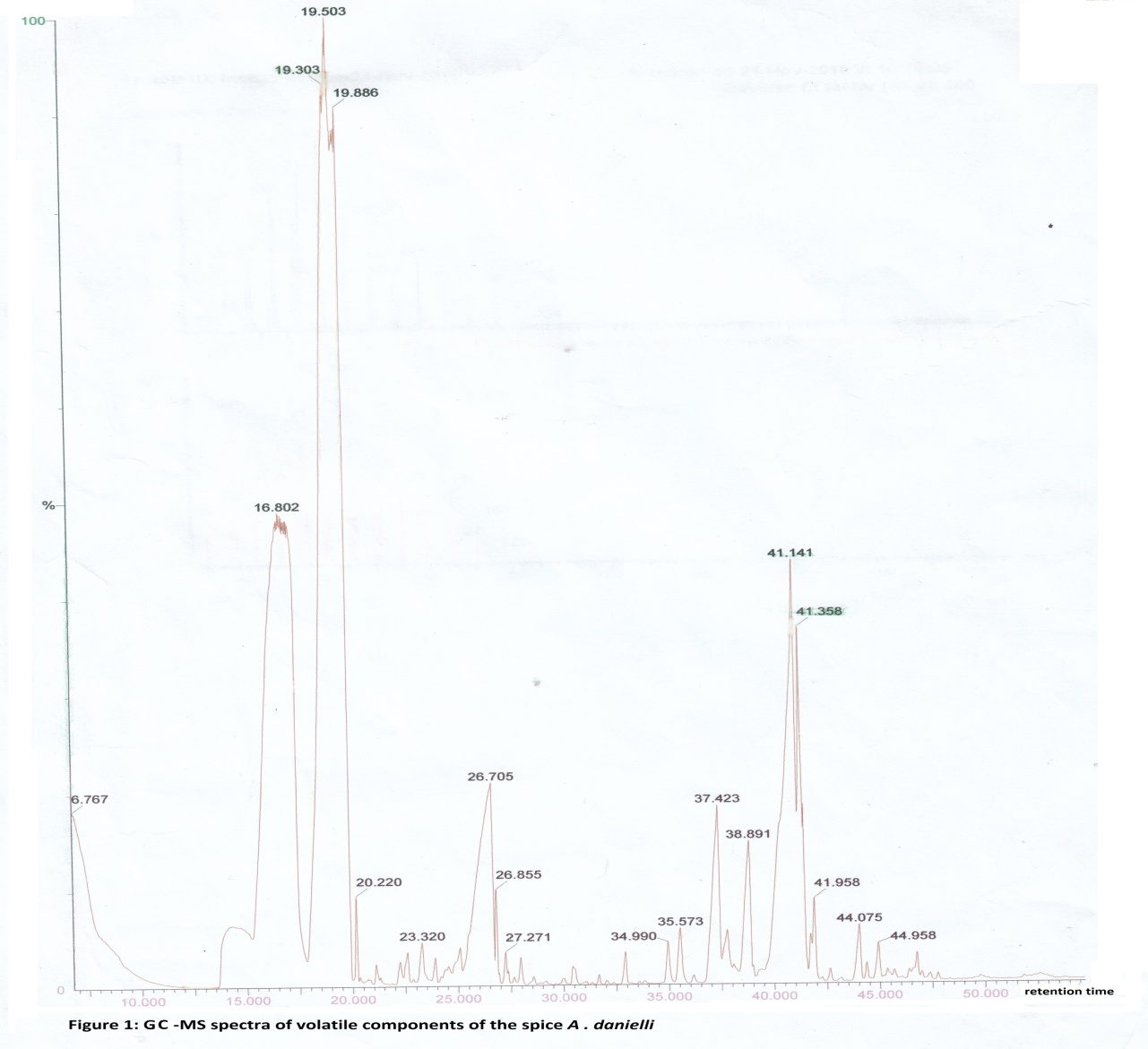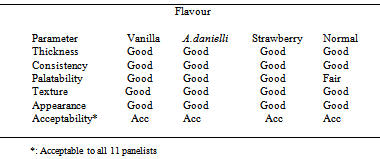-
Paper Information
- Next Paper
- Previous Paper
- Paper Submission
-
Journal Information
- About This Journal
- Editorial Board
- Current Issue
- Archive
- Author Guidelines
- Contact Us
Food and Public Health
p-ISSN: 2162-9412 e-ISSN: 2162-8440
2013; 3(2): 92-96
doi:10.5923/fph.20130302.02
Production of Probiotic Yoghurt Flavored with the Spice, Aframomum danielli, Strawberry and Vanilla
Gabriel O. Adegoke1, 2, Samson Musenbi2, Stephen Wachira2, Cecilia Muigai2, Frederick Muigai3, Elijah Ngumba3, Paul Karanja2, Christine Onyango2, George M. Adoko4
1Department of Food Technology, University of Ibadan, Ibadan, Nigeria
2Department of Food Science and Technology, Jomo Kenyatta University of Agriculture and Technology, Juja, Kenya
3Department of Chemistry, Jomo Kenyatta University of Agriculture and Technology, Juja, Kenya
4Department of Animal Science, National University of Lesotho, PO180 Roma, Lesotho
Correspondence to: Gabriel O. Adegoke, Department of Food Technology, University of Ibadan, Ibadan, Nigeria.
| Email: |  |
Copyright © 2012 Scientific & Academic Publishing. All Rights Reserved.
Probiotic yoghurt, pH 4.5, with acceptable organoleptic profiles was prepared using standard procedures. Flavouring of probiotic yoghurt was done using the spice Aframomum danielli, strawberry and vanilla. Samples flavoured with A.danielli , strawberry and vanilla though more viscous than ordinary yoghurt were generally preferred. Volatile components of A.danielli were extracted using diethyl ether, dried and concentrated followed by analysis using gas chromatography coupled to mass spectrometry. Flavour components like 2-methyl-1-propen-1-yl, 3-methylbut-2-enyl and 1-methyl-4-(1-methylethyl) reported to provide the desirable aroma and taste in yoghurt were identified in A. danielli.
Keywords: Probiotic yoghurt, Aframomum danielli, Strawberry, Vanilla, Flavouring, Volatiles, Acceptability
Cite this paper: Gabriel O. Adegoke, Samson Musenbi, Stephen Wachira, Cecilia Muigai, Frederick Muigai, Elijah Ngumba, Paul Karanja, Christine Onyango, George M. Adoko, Production of Probiotic Yoghurt Flavored with the Spice, Aframomum danielli, Strawberry and Vanilla, Food and Public Health, Vol. 3 No. 2, 2013, pp. 92-96. doi: 10.5923/fph.20130302.02.
Article Outline
1. Introduction
- The milk of cow is nutritive and it can be processed into products like cheese, butter and yoghurt and some dairy products made from cow’s milk have been reported(1) Yoghurt is a semi-solid fermented milk product that has been given different names and forms(2).The importance of yoghurt to the diet of human beings cannot be overemphasized as consumption of probiotic-containing foods has some benefits like modulation of antimicrobial and antimutagenic activities (3),antihypertension properties (4), reduction of LDL-cholestrol levels (5) and disruption of the pathogenesis of hepatic encephalopathy(6). Many consumers associate yoghurt with good health (7) and interestingly, the North American probiotic spoonable yoghurt alone had been found to have risen from US $112 in 2001 to US $294 in 2006 (8). Consumption of yoghurt is worldwide. Health benefits, convenience and sensory appeal are some of the identifiable strategies associated with the market success of functional foods like probiotic yoghurt (9). The popularity of yoghurt as a food component has been linked to its sensory characteristics (10). In order to improve the sensory and nutritional qualities of yoghurt, cashew apple additive has been used in the production of yoghurt and the product was acceptable to consumers and also had enhanced vitamin C content(11). Furthermore, strawberry and vanilla and other fruit flavours had been used in the production of standard yoghurt(12). Arising from the capability of aqueous solution of A.danielli to stabilize colour, flavour and pH of cashew juice (13) and with its health-promoting profile (14), bio-preservative properties (15) and antioxidant properties better than synthetic ones (16), and with no reports in literature on the use of A.danielli to flavour dairy products, we became interested in carrying out the present work in order to ascertain the acceptability of probiotic yoghurt flavoured with A.danielli .
2. Materials and Methods
- The work was carried out between in the laboratories of the Department of Food Science and Technology and Department of Chemistry, Jomo Kenyatta University of Agriculture and Technology, Juja, Kenya.
2.1. Aframomum danielli
- Aframomum danielli seeds were purchased in Ibadan, Nigeria and treated as described earlier (13).
2.2. Milk
- Fresh milk, skim milk, sugar, strawberry and vanilla were procured from stores in Nairobi, Kenya.
2.3. Starter Culture
- Probiotic starter culture used was freeze-dried lactic culture ABT-5 , CHR-Hausen, Denmark and solvents used were all of analytical grade.
2.4. Production of Flavored Probiotic Yoghurt
- Methods described elsewhere for yoghurt production (17,18) were used with some modifications: skim milk and sugar were mixed and added to previously warmed (45oC) fresh milk followed by heating to 90℃ for 30 minutes. After sieving and cooling to 45℃, probiotic yoghurt culture (freeze-dried lactic culture, ABT-5, CHR-Hansen, Denmark) and ordinary yoghurt starter culture were added respectively according to manufacturer’s specifications: 16.58 g to 25 litres of skim-milk- sugar mixture followed by mixing and incubation at 45℃ for 6 hours . The mixture was then refrigerated (4-10℃) for 18-24 hours. After breaking the curd, 1.0 ml of 1.0 %( w/v) aqueous solution of A.danielli was added to 19 litres of milk-sugar-culture mixture; thereafter, 0.5ml of strawberry and 2.5ml of vanilla were respectively added to 1,250 ml of milk-sugar-culture mixture. All yoghurt samples were stored at 4℃ until used for analysis.
2.5. Sensory Evaluation
- Staff and students of the Department of Food Science and Technology, Jomo Kenyatta University of Agriculture and Technology, used to consuming probiotic yoghurt , were asked to assess both flavoured probiotic and plain yoghurt samples for appearance, texture, palatability and thickness (Table 1).
2.6. Analysis of Volatile Components in Aframomum danielli
- Thirty grams of A.danielli powder was steam-distilled. The distillate was extracted with 30 ml of diethyl ether followed by drying over anhydrous sodium sulfate and evaporated with nitrogen gas. Concentrated volatiles (1 µl ) was injected into GC (GC 8000,Finnegan Co, Italy) using DB-1.60M x 0.25 mm capillary column internal diameter coated with fused silica. The GC conditions used were: column initial temperature 70℃; column initial time ,2mins, column program rate, 2 min, column final temperature, 230℃; column final time, 30 min, injector temperature, 250℃, detector temperature, 250℃, column pressure, 200kpa, hydrogen pressure, 60kpa, air, 50kpa, nitrogen gas, carrier at 200 kpa, split ration , 20:1,splitting time, 3 min , and integrator used was CR-6A Shimadzu chromatopac.
2.7. Gas Chromatography-coupled to Mass Spectrometry
- One microlitre (µl) of A.danielli volatile extract was injected into GC 8000 Top Series (Finnegan, Italy) coupled to Voyager-Finnegan Quadrupple MS detector. The GC column used was as described earlier but with a flow rate of 60ml/min and helium as the carrier gas; column temperature, 70℃, and this was maintained for 2 min, thereafter , 30℃/min up to 230℃. The conditions used for MS scans were : scan time,0.9sec, interscan delay, 0.1 sec, solvent decay, 6 min, and scan range, 50-450 daltons.
3. Results and Discussion
3.1. Sensory Evaluation
- Organoleptic profiles of stirred , probiotic yoghurt flavoured with very low concentration of A. danielli were found to be comparable to those of yoghurt samples having strawberry and vanilla (Table 1). Yoghurt samples containing probiotics , although viscous, when compared to plain (control) yoghurt sample were preferred by the panelists that tasted the samples. The popularity of yoghurt as a food component depends mainly on its sensory characteristics and addition of different flavours to yoghurt has been found to increase options for consumers and helps in marketing yoghurt and retaining consumer interests (10). In the list of plant materials which are directly in use for yoghurt production, Tamine and Robinson(2) did not include A. danielli. However, the incorporation and acceptance of flavour components of A. danielli in this present study, is similar to the report of Aroyeun (11) who used cashew apple additive in yoghurt to enhance vitamin C content of the samples. In another similar report to our present work, the pulp of ‘acai ‘( Euterpe oleracea) has been added to probiotic yoghurt and the flavoured samples with ‘acai’ were found acceptable(19). Antioxidant properties of ‘acai’ have been reported (20). Similarly, the antioxidant activities of A. danielli (16) has been reported to be more potent than butylated hydroxytoluene (BHT) and butylated hydoxyanisole (BHA). Futhermore, Daniellin TM from A.danielli has been used to extend the shelf life of a perishable, fermented, non-alcoholic beverage(21) while Ashaye et al (22) used A.danielli to preserve soft cheese.
3.2. Flavor components of A.danielli
- The GC-MS spectra of the flavour components of A.danielli showed peaks (fig 1 ) and some of these peaks were identified as cyclopheptane( 2-methyl-1-propen-1-yl ), 3-methylbut-2-enyl and heptane,1-methyl-4-(1-methylethyl) and these flavour components of A.danielli (figs 2,3) have been reported to be associated with the aroma and taste of yoghurt(23,24).α-pinene and α - erpinene found in A.danielli flavour are similar to the monoterpenes found in fresh ‘Chok Anan” mango juice ((25). Components like carene , α-humulene and α-carophyllene (spectra not shown) used in different flavouring processes are also present in A.danielli flavour. Interestingly, the flavour components found in A.danielli in this study belong to the four categories of flavour components described elsewhere( 26). With these flavours in A. danielli , it is possible that the plant material will find future applications in the brewery, dairy and meat industries.
|
 | Figure 1. GC-MS spectra of volatile component of the spice A.danielli |
 | Figure 2. Cycloehptane – flavour component of A.danielli |
 | Figure 3. 3-menthylbut -2- enyl: flavour component of A.danielli |
- In their study of soy-yoghurt using different colours and fruit flavours, Osundahunsi et al. (12) found that there were preferences for strawberry, vanilla and plain yoghurt respectively. In our present study of probiotic yoghurt, strawberry, A.danielli flavour and vanilla however had more acceptable sensory qualities than plain yoghurt ( Table 1). Report of reduction of the levels of glutamate oxaloacetate transaminase (SGOT ), glutamate pyruvate transaminase (SGPT) and alkaline phospahatase (ALT) in the sera of treated rats fed on aqueous herbal extract of plain and stirred yoghurt filtrate mixture has been reported (27). Adegoke et al. (14) reported earlier that A. danielli protected liver cells as it exerted no hepatotoxic effects on test albino rats and serum enzyme levels of SGOT, SGPT and ALP were also lowered by 67.0%, 86.3 % and 49.7% respectively. In our present study, we used A. danielli to flavour stirred probiotic yoghurt, possibly, yoghurt flavoured with A.danielli will have additional beneficial health effects on consumers than ordinary or plain yoghurt because of the natural components present in A.danielli (14, 16,21) and we are currently interested in further works in this direction.
4. Conclusions
- At relatively low concentration,. A. danielli had good sensory characteristics comparable with strawberry and vanilla with respect to appearance, texture, consistency and palatability of probiotic yoghurt. The presence of flavour components in A.danielli and natural health-promoting bioactive compounds in the plant material can be explored synergistically for use in the food industry .
ACKNOWLEDGMENTS
- Professor Gabriel O. Adegoke expresses his gratitude to the Association of African Universities for the Staff Exchange Fellowship awarded to him.
 Abstract
Abstract Reference
Reference Full-Text PDF
Full-Text PDF Full-text HTML
Full-text HTML